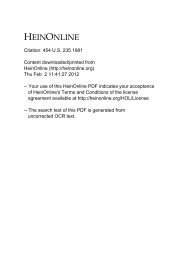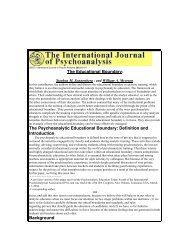Moral Rules and Moral Maxims - The University of Texas at Austin
Moral Rules and Moral Maxims - The University of Texas at Austin
Moral Rules and Moral Maxims - The University of Texas at Austin
Create successful ePaper yourself
Turn your PDF publications into a flip-book with our unique Google optimized e-Paper software.
282 ETHICSdifferent facts: On the st<strong>at</strong>e <strong>of</strong> our knowledge,on our present ability to modify certainmodes <strong>of</strong> behavior, on changingpractices, etc.It is pretty clear now th<strong>at</strong> we justmust admit the perpetual possibility <strong>of</strong>revision <strong>and</strong> indecision, in principle, forsome cases, otherwise unspecified. Butwe cannot do th<strong>at</strong> without admitting thepossibility <strong>of</strong> finality <strong>and</strong> decision, infact, in other cases. For the whole proceduredepends upon the reiter<strong>at</strong>ed establishment<strong>of</strong> new precedents.This discussion bears on the questionwhether pronouncements to the effectth<strong>at</strong> such <strong>and</strong> such would be right orwrong, uttered as conclusions <strong>of</strong> argumentswithin contexts <strong>of</strong> decision <strong>and</strong>appraisal, are properly construed astrue-or-false st<strong>at</strong>ements. <strong>The</strong>re can be nodoubt th<strong>at</strong> we make the decision or appraisalon a factual basis <strong>and</strong> th<strong>at</strong> theconclusion can be objectively right orwrong. <strong>The</strong>re would, therefore, appear tobe scope for st<strong>at</strong>ing th<strong>at</strong> the decision orappraisal is objectively right or wrong.But now we are talking about the decisionor appraisal made <strong>at</strong> a particulartime in particular circumstances, <strong>and</strong> notthe act itself, which is in principle subjectto reappraisal. Moreover, it does seem abit suspicious to docket as true-or-falsest<strong>at</strong>ements pronouncements th<strong>at</strong> acts aremorally right or wrong. <strong>The</strong> reason forthis appears, I think, by once more contrastingthe moral <strong>and</strong> legal cases.Legal decisions are made on the basis<strong>of</strong> facts <strong>and</strong> afterward we may st<strong>at</strong>etruly or falsely th<strong>at</strong> the decision was correct.But also, on the basis <strong>of</strong> the decision,we may st<strong>at</strong>e th<strong>at</strong> the man wasguilty, i.e., declared guilty. We cannot doth<strong>at</strong> in moral cases, for precisely wh<strong>at</strong> welack is the necessary formal appar<strong>at</strong>usoper<strong>at</strong>ed by authorities whose actionbrings proceedings to a close.Here again the doctrine <strong>of</strong> rules, pro-viding a general formul<strong>at</strong>ion <strong>of</strong> the truthconditionsfor st<strong>at</strong>ements th<strong>at</strong> acts areright or wrong, distorts by imposing anunwanted precision <strong>and</strong> formality.Let us now see how n<strong>at</strong>ural are some<strong>of</strong> those peculiarities <strong>of</strong> moral reasoningwhich were so badly accommod<strong>at</strong>ed bythe doctrine <strong>of</strong> rules.First, it is now no mystery th<strong>at</strong> moralpractices generally escape capture as explicitlyst<strong>at</strong>ed rules. We see th<strong>at</strong> rulesare <strong>of</strong>ten not even wanted, the reasoningproceeding from particular case to particularcase, guided by maxims.Since almost everyone must be taughtto distinguish right from wrong, <strong>and</strong>since each one is taught by others, theabsence <strong>of</strong> special moral competence <strong>and</strong>authority is no surprise. Since there areno experts, there is little room for specificmoral promulg<strong>at</strong>ion <strong>and</strong> enforcement.<strong>The</strong>refore there is little room for specificsanctions, although the concept <strong>of</strong> disapprovalis cardinal.Moreover, since we argue from precedentto precedent along a truistic line <strong>of</strong>maxims, there is room to move in all directions,by cre<strong>at</strong>ing new precedents <strong>and</strong>by extending old ones to bear on manyareas <strong>of</strong> human behavior. Thus, havingonce been given an example <strong>of</strong> beinghonest, we may l<strong>at</strong>er see wh<strong>at</strong> it is to behonest in business, in play, in discourse,etc.Also, since the maxim <strong>of</strong> universalityis fundamental to the idea <strong>of</strong> morality<strong>and</strong> since the same maxim is the normalp<strong>at</strong>h leading from precedents involvingone person to precedents involvingothers, it is n<strong>at</strong>ural th<strong>at</strong> we should conceive<strong>of</strong> moral practice as governing behaviortoward an unlimited number <strong>of</strong>people, relevant dissimilarities apart.Most important <strong>of</strong> all, it is now possibleto see how n<strong>at</strong>ural it is for moralpractices to change. In the first place, differentfactors may <strong>at</strong> different times ruleThis content downloaded on Thu, 21 Feb 2013 11:18:02 AMAll use subject to JSTOR Terms <strong>and</strong> Conditions
















